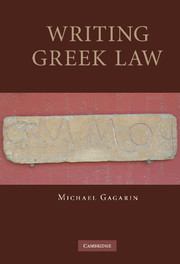Book contents
- Frontmatter
- Contents
- List of illustrations
- Preface and Acknowledgments
- List of abbreviations
- Introduction: Writing Greek Law
- Chapter 1 Law before Writing
- Chapter 2 Writing and Written Laws
- Chapter 3 Why the Greeks Wrote Laws
- Chapter 4 Why Draco Wrote his Homicide Law
- Chapter 5 Oral and Written in Archaic Greek Law
- Chapter 6 Writing Laws in Fifth-Century Gortyn
- Chapter 7 Writing the Gortyn Code
- Chapter 8 Writing Law in Classical Athens
- Chapter 9 Writing Athenian Law: a Comparative Perspective
- Chapter 10 Writing Law in Hellenistic Greece
- Conclusion: Writing Greek Law
- Appendices
- Bibliography
- Index Locorum
- Subject Index
Chapter 6 - Writing Laws in Fifth-Century Gortyn
Published online by Cambridge University Press: 22 September 2009
- Frontmatter
- Contents
- List of illustrations
- Preface and Acknowledgments
- List of abbreviations
- Introduction: Writing Greek Law
- Chapter 1 Law before Writing
- Chapter 2 Writing and Written Laws
- Chapter 3 Why the Greeks Wrote Laws
- Chapter 4 Why Draco Wrote his Homicide Law
- Chapter 5 Oral and Written in Archaic Greek Law
- Chapter 6 Writing Laws in Fifth-Century Gortyn
- Chapter 7 Writing the Gortyn Code
- Chapter 8 Writing Law in Classical Athens
- Chapter 9 Writing Athenian Law: a Comparative Perspective
- Chapter 10 Writing Law in Hellenistic Greece
- Conclusion: Writing Greek Law
- Appendices
- Bibliography
- Index Locorum
- Subject Index
Summary
In the fifth century, Greek cities everywhere continued to inscribe laws on stone and other materials and display them in public. Judging from the surviving inscriptions, the most active city in this regard continued to be Gortyn, and it is here that we can best study developments in the organization and presentation of legal texts. The crowning glory of fifth-century legal inscriptions is the Great Code (ICret 4.72), probably from about the middle of the century, with almost twelve full columns of text. We also have a second large inscription, the so-called Little Code (4.41, probably before 450), which treats damages done to and by animals, runaway slaves, and indentured servants; parts of seven columns of this text survive, and originally there must have been more. In addition, four (incomplete) columns of text survive on 4.75, traces of three columns can be seen on 4.77, and several other inscriptions originally had at least two columns of text.
The Great Code is a unique document, and its laws cover a far broader range of subjects than any other Greek legal inscription. Because of this, it will be treated separately in the next chapter, where we will also explore some of the similarities and differences between it and the Babylonian Code of Hammurabi. But even leaving aside the Great Code, Gortyn is exceptional in the quantity and diversity of inscribed legislation in the fifth century. In this chapter I examine a selection of fifth-century inscriptions from Gortyn (4.4.41–140), paying particular attention to features of style and organization.
- Type
- Chapter
- Information
- Writing Greek Law , pp. 122 - 144Publisher: Cambridge University PressPrint publication year: 2008
- 1
- Cited by



